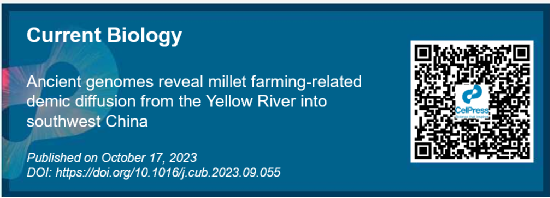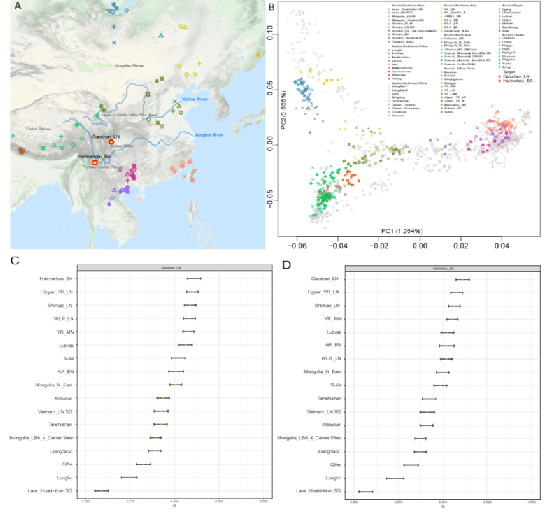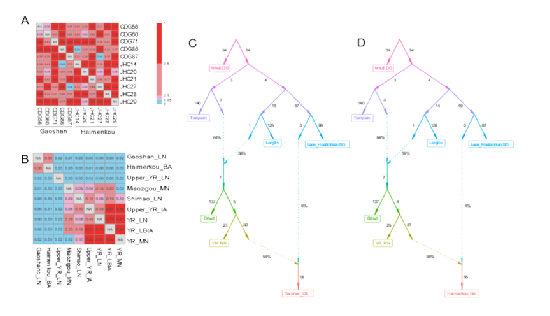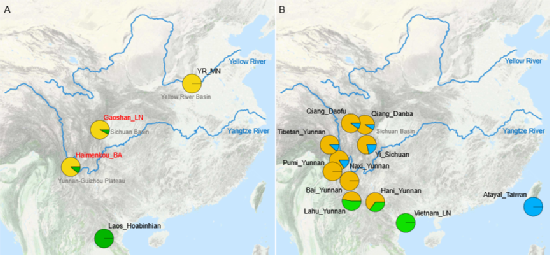Current Biology: Ancient genomes confirm that Neolithic to Bronze Age ancestors in Sichuan and Yunnan mainly came from the Yellow River Basin | Cell Press Dialogue with Scientists
Editor's Note:
The Center for Archaeological Science, Sichuan University, in collaboration with multiple institutions, uses ancient DNA to reveal the origin history of the Neolithic to Bronze Age people in Sichuan and Yunnan.
The following article is from CellPress, written by Cell Press
On October 17, 2023, a joint research team supported by the Center for Archaeological Science, Sichuan University and the Fujian Provincial Key Laboratory of Biological Anthropology, Xiamen University, and composed of Xiamen University, Sichuan University, Chengdu Institute of Cultural Relics and Archeology, Yunnan Provincial Institute of Cultural Relics and Archeology, etc., published a research paper titled "Ancient genomes reveal millet farming-related demic diffusion from the Yellow River into southwest China" in the Cell Press journal Current Biology. The paper reported for the first time the ancient genomes of agricultural populations from the late Neolithic to the Bronze Age in southwestern China, revealing that the ancestors of Sichuan and Yunnan mainly came from the Yellow River basin. This is of great significance for understanding the origin, migration, and integration history of prehistoric populations in the region. Tao Le from Xiamen University, Yuan Haibing from Sichuan University, and Zhu Kongyang from Xiamen University are the first authors of the paper, and Yuan Haibing from Sichuan University, Guo Jianxin and Wang Chuanchao from Xiamen University are the corresponding authors. Liu Xiangyu from Chengdu Institute of Cultural Relics and Archeology, Min Rui from Yunnan Provincial Institute of Cultural Relics and Archeology, and others are co-authors. This research was supported by the National Natural Science Foundation of China (32270667), the National Social Science Fund Major Project (21&ZD285), the Fujian Provincial Outstanding Youth Fund (2023J06013), the National Social Science Fund Project (19BKG038), and Sichuan University (2022CX16).

Related Background
In recent years, molecular biology has gradually been applied to archaeological research to analyze the genetic structure of ancient populations through ancient DNA and explore the relationship between agriculture and population migration. The Chengdu Plain and the Yunnan-Guizhou Plateau in southwestern China have been important areas for population exchange since ancient times. Population migration is often accompanied by changes in subsistence patterns. As early as the Middle Neolithic period, mixed rice-millet agriculture appeared in this region. Where did these mixed agricultural populations come from? What is their relationship with the current Tibeto-Burman-speaking populations? These questions have always been the focus of academic attention. Ancient DNA research may provide key clues, but the warm and humid climate in southwestern China is not conducive to the preservation of ancient DNA. Nowadays, most of the domestic ancient DNA research focuses on the north, with few research cases in the southwest. This study applied capture sequencing technology to break through the technical bottleneck of poor ancient DNA preservation in southwestern China, and successfully extracted, sequenced, and performed population genetic analysis of ancient DNA from human bone samples from the Gaoshan Ancient City of the Baodun Culture in Sichuan during the Neolithic period and the Haimenkou site in Jianchuan, Yunnan during the Bronze Age.
Interpretation of Results
First acquisition of ancient DNA from agricultural populations in southwestern China
The research team performed ancient DNA extraction, hybridization capture, and whole-genome sequencing on 89 ancient human samples from southwestern China (including 55 samples from the Gaoshan Ancient City site during the Neolithic period and 34 samples from the Haimenkou site during the Bronze Age). After a series of rigorous quality controls, 11 ancient genome data were finally obtained (including 5 Gaoshan Ancient City and 6 Haimenkou individual data). These 11 data points clustered significantly in the principal component analysis (Figure 1) and also showed high consistency in the genetic homogeneity test (Figure 2A), indicating the genetic continuity and relatively stable genetic composition of the agricultural populations in southwestern China from the Neolithic to the Bronze Age.

Figure 1 Overview of ancient human samples in this study
(A) Geographic distribution of samples; (B) PCA of major East Asian populations. Ancient human samples are projected onto the principal components calculated by modern populations, and the colors and shapes of different points represent different populations divided by geography or language; (C) and (D) outgroup-f3 (X, Y; Mbuti) calculation results for Gaoshan Ancient City and Haimenkou populations.

Figure 2 Genetic structure and admixture of ancient populations in southwestern China
(A) Pairwise qpWave homogeneity test between samples; (B) qpWave homogeneity test between southwestern China and Yellow River basin samples; (C) and (D) qpGraph model for Gaoshan Ancient City and Haimenkou samples.
2. Genetic affinity between Neolithic to Bronze Age populations in southwestern China and millet farming populations in the Yellow River basin
In the principal component analysis (Figure 1B), the research team found that the Gaoshan Ancient City and Haimenkou populations were most similar to the ancient agricultural populations in the Yellow River basin that mainly practiced millet farming (hereinafter referred to as the Yellow River agricultural populations) and the ancient people of the Qinghai-Tibet Plateau, but had significant differences from the Southeast Asian populations and ethnic minorities in South China that were geographically close. The f3 and f4 statistics also support this result (Figure 1C and D): in the test with a series of East Asian related populations, they also showed the closest genetic relationship with the ancient Yellow River basin agricultural populations, followed by the ancient populations of the Qinghai-Tibet Plateau. Combining with the previously reported studies on ancient people in the Qinghai-Tibet Plateau (Wang Chuanchao et al. 2021, Wang Haibing et al. 2023), it can be known that the main genetic component of the mixed agricultural populations in southwestern China (hereinafter referred to as the Southwest agricultural populations) that simultaneously cultivated millet and rice during the Neolithic to Bronze Age should come from the agricultural populations in the Yellow River basin.
3. Analysis of the genetic composition of the Gaoshan Ancient City and Haimenkou populations
After determining the main genetic contribution of the Yellow River basin agricultural populations to the Southwest agricultural populations, the research team further conducted genetic homogeneity testing on the Southwest agricultural populations. The results showed that there were still certain differences between the Southwest agricultural populations and the Yellow River basin agricultural populations, and the Southwest agricultural populations also retained certain other genetic components. After f4 statistical analysis of a series of East Asian related ancestral components, the genetic components related to the Laos Hoabinhian hunter-gatherer populations showed more obvious signals. Subsequently, the ancestral modeling analysis results showed that the Southwest agricultural populations should be formed by the mixing of ancient millet agricultural populations in the Yellow River basin (approximately 90%) and Hoabinhian hunter-gatherer populations (approximately 10%) (Figure 3A). Among them, the Yellow River agricultural population component of the Gaoshan Ancient City population was larger, at approximately 92.1%; while the Haimenkou ancient population was approximately 88.7%, showing a decreasing trend from north to south.
The Hoabinhian population genetic components mainly originated from hunter-gatherer populations distributed in Southeast Asia and the Yunnan region of China around 8000~4000 years ago, and this genetic component also exists in the ancient Baoshan sample in Guangxi, China (Wang Chuanchao et al. 2021). The Hoabinhian-related genetic components in the Southwest agricultural populations are likely derived from the local ancient hunter-gatherer populations. With the migration and diffusion of populations, the retained components in the ancient populations in southwestern China gradually declined.

Figure 3 qpAdm ancient and modern population mixing model
(A) Mixing model of Gaoshan Ancient City and Haimenkou populations, where yellow represents the genetic components of the Middle Neolithic population in the middle reaches of the Yellow River (YR_MN), and green represents the genetic components of the ancient Hoabinhian population in Laos (Laos_Hoabinhian); (B) Mixing model of the main Tibeto-Burman-speaking populations in modern Yunnan and Sichuan regions. Orange represents the genetic components of the Haimenkou (Haimenkou_BA) population, green represents the genetic components of the late Neolithic population in Vietnam (Vietnam_LN), and blue represents the genetic components of the Atayal tribe of Taiwan aborigines (Atayal_Taiwan).
4. Exploring the genetic formation of modern Tibeto-Burman-speaking populations in southwestern China
Modern Tibeto-Burman-speaking populations in southwestern China, such as the Qiang, Naxi, Yi, Bai, and Pumi, still retain a large number of genetic components related to the ancient Gaoshan Ancient City and Haimenkou populations (Figure 3B), which to some extent supports the northern origin theory of the Sino-Tibetan language family. In addition, some Tibeto-Burman-speaking populations have also been influenced by the Kra-Dai-related populations in South China and Southeast Asia, showing an overall genetic characteristic of north-south mixing.
Summary
This study, through the study of ancient population DNA from the Gaoshan Ancient City and Haimenkou sites, reveals that the mixed rice-millet agricultural populations in southwestern China during the Neolithic and Bronze Ages should be driven by the southward migration of millet populations in the Yellow River basin. This genetic pattern spans the late Neolithic to the Bronze Age, lasting for at least a thousand years. Mixed rice-millet agriculture is likely the result of environmental adaptation in which millet populations integrated rice cultivation techniques from South China during their southward migration, and the genetic influence of rice-farming populations on the then southwestern Chinese populations was not obvious. The genetic structure of the region has been basically stable since at least the late Neolithic period, and has been continuously inherited in the subsequent three to four thousand years.
References
1. Wang, C.-C., et al. (2021). Genomic insights into the formation of human populations in East Asia. Nature 591(7850): 413-419.
2. Wang, H., et al. (2023). Human genetic history on the Tibetan Plateau in the past 5100 years. Science Advances 9(11): eadd5582.
3. Wang, T., et al. (2021). Human population history at the crossroads of East and Southeast Asia since 11,000 years ago. Cell 184: 3829-3841.e3821.
Author Interview
Cell Press has specially invited researcher Wang Chuanchao for an interview, please ask him to further explain in detail for everyone.
CellPress:
What are the main difficulties in studying ancient DNA in southwestern China?
Professor Wang Chuanchao:
Ancient DNA is a relatively new research direction in the past decade, mainly applying molecular biology technology to archaeological research. In recent years, Chinese ancient DNA researchers have achieved many results, but most of them are cases in the northern region. Northern China is relatively cold and dry, which is more suitable for ancient DNA preservation; while the southern region has a warm and humid climate, and the soil is mostly acidic, which is very unfavorable for DNA preservation. The current world's leading ancient DNA research is also mainly concentrated in Europe, and there are very limited similar environments for reference. This poses a great challenge to ancient DNA research in southern China. The ancient human samples from the Gaoshan Ancient City site in Sichuan used in the study are mostly in a water-saturated environment, which brings greater difficulties to the extraction of ancient DNA. We collected teeth, temporal bones and other parts where ancient DNA is mainly enriched, improved the library construction plan and applied the most advanced capture technology, and finally obtained 11 high-quality ancient genomes.
CellPress:
What are the main highlights of this study?
Professor Wang Chuanchao:
There was no ancient DNA data related to agricultural populations from the Neolithic to the Bronze Age in the Yunnan-Guizhou-Sichuan region before. We filled this missing piece of the puzzle, which is very important for the diffusion of agriculture, the migration of populations, and the exploration of the transmission routes of millet agriculture and rice agriculture. Both millet and rice were unearthed at the Gaoshan Ancient City and Haimenkou sites. The southwestern region is a typical mixed agricultural area and an important area for population movement. Previously, agricultural research in this region focused on archaeological research. Now, with the help of ancient DNA technology, we can further interpret it from a genetic perspective. In fact, the main genetic components of the ancient people in this region come from the millet agricultural populations in the Yellow River basin and a small part of the ancient hunter-gatherer populations. No gene flow influence from the Southeast Asian rice agricultural populations has been found. This genetic composition is also very similar to the formation model of the ancient people on the Qinghai-Tibet Plateau, which supports the common origin of Sino-Tibetan and the northern origin theory of the Sino-Tibetan language family.
CellPress:
What are the main challenges currently encountered in the field of ancient DNA? What are the future development directions?
Professor Wang Chuanchao:
At present, domestic ancient DNA research has made breakthrough progress, but there are still many problems to be solved. First, many ancient DNA studies are still limited to the experimental techniques and methods of more than 20 years ago, and it is difficult to effectively analyze and process genomic big data; second, bioarchaeological research related to ancient DNA is not systematic, involving archaeology, physical anthropology, molecular biology, bioinformatics, history, chemistry and other disciplines. There is a lack of effective communication, exchange and cooperation, which also leads to limited channels for funding applications and difficulties in interdisciplinary talent training; third, the preservation of ancient human remains and animal and plant remains is poor, and how to effectively extract and enrich ancient DNA is a difficult point in domestic research and a key point to be broken through.
In response to the current status of ancient DNA research in China, our research on human bones, animal and plant remains unearthed from ancient tombs needs to comprehensively and deeply integrate many disciplines of natural sciences and humanities and social sciences, strengthen communication, exchange, cooperation and mutual trust between disciplines, and actively expand channels for funding applications; guided by answering major scientific questions, encourage and support cross-regional and interdisciplinary cooperative research, and cultivate outstanding interdisciplinary talents; strengthen the protection and utilization of ancient humans and ancient animal and plant remains unearthed from archaeological sites; formulate, publish and implement industry standards for DNA sampling and laboratory operation of biological remains, enhance the scientificity of field archaeological sampling work, improve the technical level of laboratory analysis and testing, and improve the disciplinary system of related ancient DNA research.
We need to continuously promote the deep cross-integration of archaeology and natural science and technology, use new biological technologies and methods to broaden the spatial and temporal scope and coverage of archaeological research, the research of human biological genealogy and archaeological cultural genealogy learn from each other, verify each other, and complement each other, and further answer many major questions in the origin and evolution of human beings, the origin and spread of agriculture, and the origin and development process of civilization. The development of sequencing technology and genomics may further improve the quality of existing ancient DNA data, and also provide us with the possibility to interpret ancient DNA data from more perspectives, such as the comparison and research of specific genes, which can more deeply interpret human evolution and environmental adaptation, diseases and health conditions. In addition, the research on ancient DNA of other species is also gradually increasing, and ancient DNA is also playing an increasingly important role in analyzing the genealogy of ancient organisms and exploring the domestication and domestication process of animals and plants.
Author Introduction
Yuan Haibing is an associate professor and master's supervisor at the School of History and Culture, Sichuan University, and is currently the executive deputy director of the National Experimental Teaching Demonstration Center for Archaeology, Sichuan University. His research interests mainly include bioarchaeology, human skeletal archaeology, and pre-Qin archaeology. He is committed to conducting systematic research with human biological remains as the core, combining ancient DNA, isotope technology, etc., and focusing on exploring the formation process of ancient and modern ethnic groups, cultural changes and civilization development from the perspectives of population migration and interaction, cultural exchange and collision, and the process of population physical development and ethnic integration. So far, he has published more than 50 papers in important domestic and international academic journals, co-edited 9 books or archaeological reports, and has presided over/is researching 2 National Social Science Fund projects, 1 China Postdoctoral Science Foundation project, and multiple other cooperative projects.
Guo Jianxin is a tenure-track associate researcher at the Institute of Anthropology, Xiamen University, and a postdoctoral fellow at the University of Mainz, Germany. His main research interests are ancient genomics and archaeological anthropology, focusing on the evolutionary history of ethnic groups in southern China and Southeast Asia. He has published 7 papers as the first author in domestic and international SCI and SSCI journals such as the American Journal of Biological Anthropology and the Annals of Human Biology. He has successively presided over research projects such as the China Postdoctoral Science Foundation and the National Social Science Fund Youth Project.
Wang Chuanchao is a professor, doctoral supervisor, and director of the Institute of Anthropology, Xiamen University, director of the Fujian Provincial Key Laboratory of Biological Anthropology, Xiamen University, chief expert of the National Social Science Fund Major Project, Young Scholar of the Ministry of Education (2021), Fujian High-level A-level Talent, and Xiamen High-level A-level Talent (national-level leading talent). In the past five years, he has published research papers as a corresponding author in well-known domestic and foreign journals such as Nature, Nature Communications, Current Biology, and Science Bulletin, finely analyzing the genetic structure of East Asian populations, systematically reconstructing the formation history of East Asian populations, providing ancient genomic evidence for the common origin of Sino-Tibetan and the common origin of Austronesian and Kra-Dai, refuting the African origin theory of modern languages and the agricultural transmission hypothesis of the Pan-Eurasian language, developing the origin and diffusion hypothesis of the Indo-European language, and promoting the application of human genomic big data in forensic medicine. He has presided over the National Social Science Fund Major Project and received rolling funding, the National Natural Science Foundation Surface and Youth Project, the Fujian Provincial Outstanding Youth Fund, and projects entrusted by ministries and commissions. He was selected as the Elsevier 2021 and 2022 China Highly Cited Scholars list, served as the associate editor and editorial board member of multiple SCI and SSCI journals, and the editorial board member of the Acta Anthropologica Sinica, and won multiple provincial and ministerial-level scientific research awards.
Related Paper Information
The original paper was published in Cell Press
in the journal Current Biology,
Click "Read the original text" or scan the QR code below to view the paper
鈻孭aper Title:
Ancient genomes reveal millet farming-related demic diffusion from the Yellow River into southwest China
鈻孭aper Website:
https://www.cell.com/current-biology/fulltext/S0960-9822(23)01303-9
鈻孌OI:
https://doi.org/10.1016/j.cub.2023.09.055
